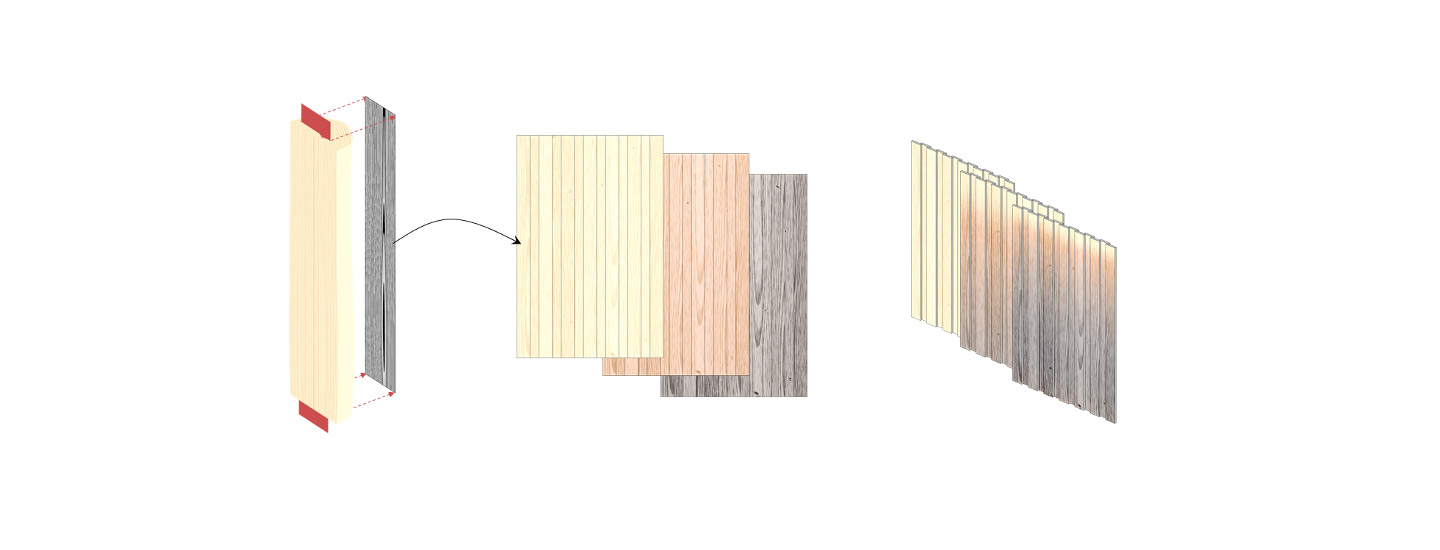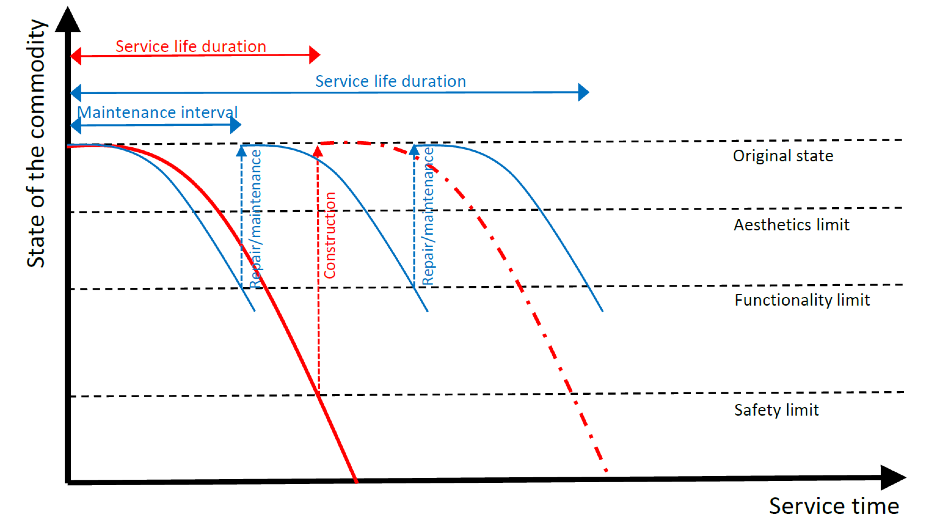Predicting service life of timber structures

|
| The image above shows the method currently used by the prototype CLICKDesign tool, where the wood texture is rendered from a 3D model and projected onto a wooden cladding, whereafter the end user can change the degree of weathering to explore how the visual appearance of the wall will change over time. |
Contents |
[edit] Introduction
Timber structures and commodities are exposed to several mechanisms that limit their service life. The term service life refers to the duration until a limit state is reached, i.e. when the performance is no longer deemed acceptable.
A structure can have several limit states relating to different performance criteria, such as safety, functionality and aesthetics. The service life depends on a set of relevant performance criteria, the acceptable limits states, the mechanisms involved as well as maintenance to counteract the effect of those mechanisms. For example, a façade should remain tight, maintain some level of structural integrity and remain aesthetically appealing. See the illustration in the figure below for additional examples.

|
As such, there are several mechanisms and limit states involved in the service life assessment. On the other hand, the main concern of a structural beam is safety, which often involves only wood-destroying fungi as degrading mechanism.
[edit] From research to practice
The CLICKDesign project aims at developing a tool to predict service life for timber elements and structures. The general objective of WP6 is to bridge the gap between research and practice. In short, WP6 receives input from other WPs (which are specialized on specific limit states) and puts it into an easy-to-use format, i.e. delivering fingertip knowledge to enable service life specification of wood to the end-user.
By having a WP dedicated to parsing and putting research output into context, the goal is to increase the project’s impact and value creation to the end user. The end user is anyone who is interested in the long-term performance of wood but unable to read scientific papers and parse the raw data.
[edit] Importance of context
Sometimes, scientific models are simply not convenient to use. For example, we can model the biological degradation of a specific joint in a timber deck made of spruce sapwood using a variety of complex moisture transport models and decay prediction models. However, most end users are not familiar with such models, nor do they have time to wait for hours to get the results.
Other times, the research output needs context. For example, we can predict how the colour of a wooden board changes over time due to superficial photo-degradation, but the end user is left wondering how this will affect their deck or house. Similarly, we can predict how quickly termites degrade various wood species, but the end user is perhaps more interested in how they can stop termites from getting into their house in the first place.
Context is key in bridging the divide between research and end user. We can remove the need for complex models by delivering pre-calculated scenarios and decay maps, we can provide tools to simulate the aesthetical changes of wood structures and we can work towards providing more general guidelines and recommendations to home owners in termite-risk zones.
[edit] Challenges
The work of WP6 is extremely interdisciplinary. We need to follow and understand most of the activities in the project without going too much into detail. Being creative and flexible is key, as we often encounter new types of challenges. For example, a key part in modelling the visual appearance of wood is to visualise organic wood texture.
A first version of the tool is planned to be tested against wood industry people and architects during 2020-2021.
This article originally appeared on the BRE website. It was written by Jonas Niklewski and Eva Frühwald Hansson and published in December 2020.
[edit] Related articles on Designing Buildings Wiki
- Aesthetics and performance.
- BRE articles on Designing Buildings Wiki.
- Decking.
- Physical Properties of Wood.
- Recognising wood rot and insect damage in buildings.
- Testing timber.
- The use of timber in construction.
- Timber vs wood.
[edit] External resources
Featured articles and news
RTPI leader to become new CIOB Chief Executive Officer
Dr Victoria Hills MRTPI, FICE to take over after Caroline Gumble’s departure.
Social and affordable housing, a long term plan for delivery
The “Delivering a Decade of Renewal for Social and Affordable Housing” strategy sets out future path.
A change to adoptive architecture
Effects of global weather warming on architectural detailing, material choice and human interaction.
The proposed publicly owned and backed subsidiary of Homes England, to facilitate new homes.
How big is the problem and what can we do to mitigate the effects?
Overheating guidance and tools for building designers
A number of cool guides to help with the heat.
The UK's Modern Industrial Strategy: A 10 year plan
Previous consultation criticism, current key elements and general support with some persisting reservations.
Building Safety Regulator reforms
New roles, new staff and a new fast track service pave the way for a single construction regulator.
Architectural Technologist CPDs and Communications
CIAT CPD… and how you can do it!
Cooling centres and cool spaces
Managing extreme heat in cities by directing the public to places for heat stress relief and water sources.
Winter gardens: A brief history and warm variations
Extending the season with glass in different forms and terms.
Restoring Great Yarmouth's Winter Gardens
Transforming one of the least sustainable constructions imaginable.
Construction Skills Mission Board launch sector drive
Newly formed government and industry collaboration set strategy for recruiting an additional 100,000 construction workers a year.
New Architects Code comes into effect in September 2025
ARB Architects Code of Conduct and Practice available with ongoing consultation regarding guidance.
Welsh Skills Body (Medr) launches ambitious plan
The new skills body brings together funding and regulation of tertiary education and research for the devolved nation.
Paul Gandy FCIOB announced as next CIOB President
Former Tilbury Douglas CEO takes helm.
UK Infrastructure: A 10 Year Strategy. In brief with reactions
With the National Infrastructure and Service Transformation Authority (NISTA).























